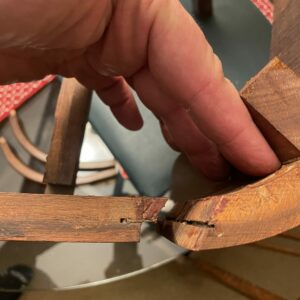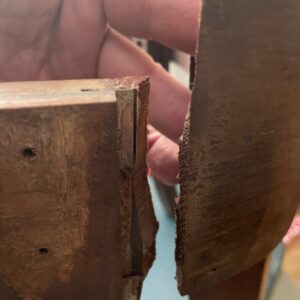I am looking for the best advice on how to repair a broken frame on a vintage sewing chair. The joinery is a metal plate that seemed to function like a mortise and tenon joint. The wood near the joint is completely broken although the joint is intact. I’m wondering what the best way is to repair the break. Initially I thought I might be able to drill holes to join the two pieces together with dowels but the metal plate would interfere with that. I was also thinking about using glue to attach the wood at the break and add metal mending plates on the top and bottom of the rail. I am interested in what others think. Thank you!
Discussion Forum
Get It All!
UNLIMITED Membership is like taking a master class in woodworking for less than $10 a month.
Start Your Free TrialCategories
Discussion Forum
Digital Plans Library
Member exclusive! – Plans for everyone – from beginners to experts – right at your fingertips.
Highlights
-
Shape Your Skills
when you sign up for our emails
This site is protected by reCAPTCHA and the Google Privacy Policy and Terms of Service apply. -
 Shop Talk Live Podcast
Shop Talk Live Podcast -
 Our favorite articles and videos
Our favorite articles and videos -
E-Learning Courses from Fine Woodworking
-
-














Replies
The metal plate is inserted by a press and brings the parts together as it is pressed in. It is not repairable as such, the two parts can be brought together and glued with JB weld epoxy if the joint is not under much stress in use.
It would help if we could see an overall picture so we could get better knowledge of where the breaks are in relation to the rest of the chair.
Also, are you wanting to repair the chair for use or display? And, are you wanting the repair for strictly structural reasons or are you repairing and restoring an antique.
My first reaction to your first picture is that the metal plate is an earlier attempt to repair the break. Can you confirm?
Those are corrugated fasteners, the metal version of splines for factory-made furniture and pressed in as Gulfstar says. That break is toast if the plan was to re-use the steel fastener.
With that curve to deal with I would be thinking about converting it to a scabbed-in half-lap. The big problem is the inability to take the rest of the chair apart. Tough spot if the chair really MATTERS, easy firewood if it does not.
I plan to repair this chair for use for a friend. I am actually restoring the entire chair which involves re-gluing due to loose joints and the broken section I’m seeking advice on. It eventually will be refinished and reupholstered. The metal plate is how the Curved pieces of the seat frame were joined during manufacturing. I am attempting to repair the broken joint that has the C clamp on it. (See additional pics) I cleaned the joint and use some j weld epoxy to rejoin it but I’m wondering if that is enough.
That's not enough.
This chair right here is how the furniture industry died. It's just crappy, crappy joinery. Sorry, it's not you, but it's just sad that they made stuff this way.
I think you need something to solidify the whole chair, or it will happen again.
If it were me, I'd consider making a tight fitting wooden plate that fits the whole seat area, with cutouts for the legs and such. I'd use Baltic birch. Maybe two layers. Glue it in. Use pocket screws to bind all the various bits to the new core.
I'd don't know if I'd do it, but I'd consider it, and other possibilities. But that chair won't stand up to use as it is. The present break will break again, or it will break in another spot.
If it were mine, and wanted it as a piece of decor, I'd patch it up and never ever sit in it. I'd use another chair, with actual joinery, to sit in.
We complain about Ikea furniture, but our grandparents and great grandparent made really crappy furniture first.
I mean no offense. I'll try to think of other fixes.
That is a good view, seems you have room inside the seat to put a block of wood to strengthen the repair. The trick will be to have a clean flat surface to glue the block. If that block could also be made to strengthen the whole corner such as the front diagonals and tie the leg to the side it would become the stress bearing component and the actual repair would become aesthetic.
These blocks were added to secure permanently the legs of an old « Chesterfield « .
Maybe drill-in and epoxy two metal rods from the front of the chair stile and then cover with plugs. If you are refinishing the whole chair, the plugs will barely be noticed.
Might a metal draw-tite/dog bone fastener be used? I have not used one on parts less than 3/4" in thickness, but the inside surface could be padded out as needed beneath the cushion. If you have a metal worker near by, a piece of flat stock could be bent to shape to fit from the curve to span the break.
I’d like to thank everyone for their informative responses. I’ve decided to add the wood blocks as suggested by gulfstar. There already were these types of blocks but they were split so I’ve repaired them and will add additional supports underneath them. Thank you again everyone for your suggestions.
This forum post is now archived. Commenting has been disabled